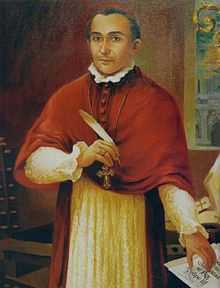Miguel de Benavides
| The Most Reverend Miguel de Benavides | |
|---|---|
| Archbishop of Manila | |
 | |
| Province | Manila |
| See | Manila |
| Installed | October 7, 1602 |
| Term ended | July 26, 1605 |
| Predecessor | Ignacio Santibáñez, O.F.M. |
| Successor | Diego Vázquez de Mercado |
| Other posts | Bishop of Nueva Segovia |
| Orders | |
| Ordination | 1568 |
| Personal details | |
| Born |
c. 1552 Carrion de los Condes, Spain |
| Died |
26 July 1605 (aged 52–53) Manila, Spanish East Indies |
| Nationality | Spanish |
| Denomination | Roman Catholic |
| Styles of Arzobispo Miguel de Benavides | |
|---|---|
.svg.png) | |
| Reference style | Monseñor |
| Spoken style | Su Excelencia Reverendísima |
| Religious style | Reverendísimo |
Miguel de Benavides y Añoza (c. 1552 – July 26, 1605) was a Spanish clergyman and sinologist, the first Bishop of the Diocese of Nueva Segovia, the third Archbishop of the Archdiocese of Manila, and founder of the University of Santo Tomas in Manila.[1]
Biography
Miguel de Benavides was born in 1552, to a noble family in Carrión de los Condes, Spain. He entered the Dominican Order in San Pablo de la Moraleja, Valladolid, and later rendered service in Colegio de San Gregorio.[1]
He joined the first group of Dominicans going to Manila in 1587, proceeding with them on to China where he hoped to expand the local Catholic church. He was later exiled, and established a hospital for the Chinese in Binondo, Manila, before becoming the head of his order. He accompanied Archbishop Domingo de Salazar to Spain to defend the native Filipinos against Spanish oppression.[1]
Bishop
He was appointed as the first bishop of Nueva Segovia and was consecrated in Mexico in 1597. He authored the Doctrina Christiana in Chinese, the first book printed in the Philippines. He arrived in Nueva Segovia in 1599 but was, after three years, appointed as the Archbishop of Manila on October 7, 1602. His consecration in Manila was financed by King Philip III himself, for Benavides was extremely poor. On September 9, 1603, he directed the Franciscans to oversee the Japanese staying in the Philippines. In the same year, he was accused of participating in the killing of thousands of Chinese during the Chinese rebellion in Manila.[1]
He died on July 26, 1605 in Manila.
His library and personal property worth ₱1,500 were donated for the establishment of an institution of higher learning, the University of Santo Tomas.[1]
See also
- Roman Catholic Archdiocese of Manila
- Roman Catholic Archdiocese of Nueva Segovia
- University of Santo Tomas
- Miguel de Benavides Library
- History of University of Santo Tomas
- Roman Catholicism in the Philippines
- First book of the Spanish Philippines
References
External links
- Miguel de Benavides Library - University of Santo Tomas
- Roman Catholic Archdiocese of Manila - Official website
- Manila Metropolitan Cathedral - Official website
| Religious titles | ||
|---|---|---|
| Preceded by Ignacio Santibáñez |
Archbishop of Manila 1602–1605 |
Succeeded by Diego Vázquez de Mercado |